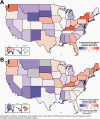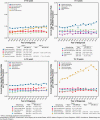CBTRUS Statistical Report: Pediatric Brain Tumor Foundation Childhood and Adolescent Primary Brain and Other Central Nervous System Tumors Diagnosed in the United States in 2014-2018
- PMID: 36066969
- PMCID: PMC9447434
- DOI: 10.1093/neuonc/noac161
CBTRUS Statistical Report: Pediatric Brain Tumor Foundation Childhood and Adolescent Primary Brain and Other Central Nervous System Tumors Diagnosed in the United States in 2014-2018
Abstract
The CBTRUS Statistical Report: Pediatric Brain Tumor Foundation Childhood and Adolescent Primary Brain and Other Central Nervous System Tumors Diagnosed in the United States in 2014-2018 comprehensively describes the current population-based incidence of primary malignant and non-malignant brain and other CNS tumors in children and adolescents ages 0-19 years, collected and reported by central cancer registries covering approximately 100% of the United States population. Overall, brain and other CNS tumors are the most common solid tumor, the most common cancer, and the most common cause of cancer death in children and adolescents ages 0-19 years. This report aims to serve as a useful resource for researchers, clinicians, patients, and families.
© The Author(s) 2022. Published by Oxford University Press on behalf of the Society for Neuro-Oncology. All rights reserved. For permissions, please e-mail: journals.permissions@oup.com.
Figures

















References
-
- National Cancer Institute. Overview of the SEER Program. http://seer.cancer.gov/about/overview.html.
-
- Fritz A, Percy C, Jack A, Shanmugaratnam K, Sobin L, Perkin DM, Whelan S, eds. International Classification of Diseases for Oncology. 3rd ed. World Health Organization; 2000.
-
- Cancer Registries Amendment Act, 102nd Cong. § 515 (1992). https://www.govinfo.gov/content/pkg/STATUTE-106/pdf/STATUTE-106-Pg3372.pdf. Accessed July 21, 2020.
-
- Benign Brain Tumor Cancer Registries Amendment Act, 107th Cong. § 260 (2002). http://www.gpo.gov/fdsys/pkg/PLAW-107publ260/pdf/PLAW-107publ260.pdf. Accessed July 21, 2020.
-
- Louis DN, Ohgaki H, Wiestler OD, Cavanee WK, eds. WHO Classification of Tumours of the Central Nervous System. Lyon, France: International Agency for Research on Cancer; 2016.
Publication types
MeSH terms
LinkOut - more resources
Full Text Sources
Medical

